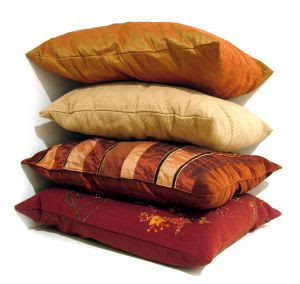Everyone wants to have a comfortable sleep and for getting this, they take help of good comfortable cushions and mattress. However, it is important to recognize that they can be hazardous enough to kill people. You will be surprised by hearing the fact that cushions are small zoos which contain millions of fungal spores, together with some species having ability to cause diseases and even death. At home and in hospitals, cushions have been unnoticed as they are breeding grounds for communicable germs, including superbugs, as per the recent study cited by The London Times. However, dandruff, dirty air, dead skin and infected fluids found on cushions expose people to the risk of diseases varying from seasonal flu to hepatitis, chickenpox and even leprosy.
After 2 years of use, more than 1/3rd of a cushion's weight consists of living and dead dust mites, dead skin, dust mite feces and bacteria, according to the research from UK public healthcare provider Barts and the London NHS Trust. Researchers have found that standard-issue hospital cushions are potential vehicles for infections like Clostridium difficile (C. diff) and Methicillin-resistant staphylococcus aureus (MRSA).
Dr. Art Tucker, principal clinical scientist and lead researcher of St. Barts Hospital said that many people cover their cushion with new cushion case to look fresh and clean but actually they are wrapping up something nasty underneath. At outer side as well as inner side, the growth of bacteria increases. He also said, some bacteria and fungi that found in cushions can never be killed. They all are responsible for E.coli, breathing, urine and transition related diseases.
Recent study presented at the Healthcare Associated Infections 2011 conference in London has compared the condition of standard hospital pillows with a medical pillow manufactured by the company Gabriel Scientific throughout several months on dissimilar wards at the hospital. The study revealed that medical cushions are devoid of all bacteria while the standard pillows contain a range of micro-organisms.
Aspergillus fumigates, another most commonly found species in the cushions, is most likely to develop the disease Aspergillosis. Aspergillosis is the leading contagious cause of death in bone marrow transplant and leukaemia patients. Fungi also worsen asthma in adults. Researchers have suggested that among hospitalized patients, the risk of actual transmission of infections is very high.
How to avoid these dangers?
After 2 years of use, more than 1/3rd of a cushion's weight consists of living and dead dust mites, dead skin, dust mite feces and bacteria, according to the research from UK public healthcare provider Barts and the London NHS Trust. Researchers have found that standard-issue hospital cushions are potential vehicles for infections like Clostridium difficile (C. diff) and Methicillin-resistant staphylococcus aureus (MRSA).
Dr. Art Tucker, principal clinical scientist and lead researcher of St. Barts Hospital said that many people cover their cushion with new cushion case to look fresh and clean but actually they are wrapping up something nasty underneath. At outer side as well as inner side, the growth of bacteria increases. He also said, some bacteria and fungi that found in cushions can never be killed. They all are responsible for E.coli, breathing, urine and transition related diseases.
Recent study presented at the Healthcare Associated Infections 2011 conference in London has compared the condition of standard hospital pillows with a medical pillow manufactured by the company Gabriel Scientific throughout several months on dissimilar wards at the hospital. The study revealed that medical cushions are devoid of all bacteria while the standard pillows contain a range of micro-organisms.
Aspergillus fumigates, another most commonly found species in the cushions, is most likely to develop the disease Aspergillosis. Aspergillosis is the leading contagious cause of death in bone marrow transplant and leukaemia patients. Fungi also worsen asthma in adults. Researchers have suggested that among hospitalized patients, the risk of actual transmission of infections is very high.
How to avoid these dangers?
- Encase cushions with vapor permeable fabrics or zippered plastic.
- Use polyurethane-covered mattress and bedding encasings as they are impervious to allergens. However, they absorb perspiration and permit the body to “breathe.”
- Purchase allergen-resistant coverings of cushion.
- Hypoallergenic cushions prepared from polyester fibers are also a best option.
- Every one to two years, change your cushions; and more frequently for asthma and allergy sufferers.
- In the meantime, additional buildup of dust mites will be combated with regular laundering of cushion encasings in hot water.









0 comments:
Post a Comment